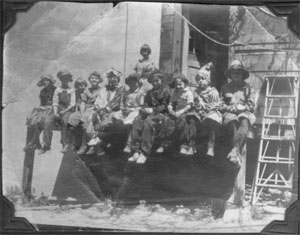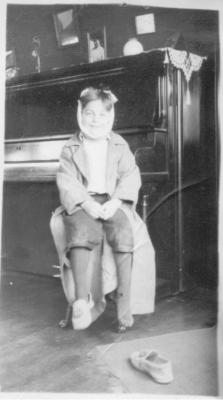This first appeared in the Montclarion May 7, 2004. Images courtesy of Bud Veirs.
 The hills neighborhood of Glenview may seem like a fairly pleasant little area, but once violence here was so severe it made Gangs of New York look like Rebecca of Sunnybrook Farm. That’s right, gang warfare once rocked these placid streets.
The hills neighborhood of Glenview may seem like a fairly pleasant little area, but once violence here was so severe it made Gangs of New York look like Rebecca of Sunnybrook Farm. That’s right, gang warfare once rocked these placid streets.
Our story starts on Galvin Street, a one-block street situated west of Park Boulevard. Here, in the seemingly peaceful bungalows, trouble brewed. The youths of Galvin Street were hardboiled toughs, and in the mid-1920s the tension overflowed. The Galvin Street Gang launched all-out warfare against the other crew in the neighborhood, the kids on Elbert Street.
My informant is Bud Veirs, a former Galvin Street gangster now living in Placerville. He is 87, and recently spent a day with me giving me all the dope about Glenview. He grew up in the house at 1025 Galvin St., the second house to be built on the block. He and his siblings would play in the vacant lot next door. They "borrowed" lumber from the piles for new construction and constructed treehouses in the high eucalyptus trees behind their house. They also dug out caves in the lot to enrich their imagination-filled play, and roasted potatoes with a stovepipe stove they manufactured. But behind such innocence, trouble was stirring, just as surely as new houses were being built.
Soon, Galvin Street was a real neighborhood, with houses tucked closely together. And in each house was a kid or two: a perfect recipe for calamity.
On just this short street, a dozen kids of roughly the same age now lived. And they stretched their necks to look across the canyon that divided their street from Elbert Street, and saw that there were other youngsters over there. Those kids looked back at them, malevolently.
 "They’d come over and raid us," Veirs told me. "I was the littlest one of the group and I’d climb into the crow’s nest (one of the treehouses he’d built) and they’d throw rocks at it."
"They’d come over and raid us," Veirs told me. "I was the littlest one of the group and I’d climb into the crow’s nest (one of the treehouses he’d built) and they’d throw rocks at it."
The Galvin Street Gang fought back. "We’d heave clay over to the Elbert Street gang on sticks," he said.
We should all be grateful there is anything at all left of Glenview today!
Veirs was able to case the joint, by delivering broadsides around the neighborhood. He complained to me that he had to bring the paper all the way up to each person’s porch, and that the steep nature of San Sebastian Avenue made it the "toughest."
Veirs attended Oakland High School, and walked there via a footpath that began in his neighborhood. He and his friends played football up on Everett Street, but "old man Hirsch," who lived just around the corner would always call the police on the loud players. Veirs got him back once by having a friend ring the doorbell. When Hirsch opened the door, Veirs was standing across the street with an egg, which he hurled directly into the man’s house. Then, as was requisite, he ran like crazy.
As we drove around the area, Veirs told me that where Radio Shack is used to be a meat market. This market had live chickens and would pay kids to sit outside and "pick" them. The Blackberry Bistro used to be a drugstore. The Savemore Market was owned by a Santa Clara football star. The Cutting Place has always been a hair salon, but back then the haircuts were 50 cents. He pointed out the neighborhood residence of the junkman, who used to go door to door to pick up people’s used goods, a trade that no longer exists today.
We drove down Trestle Glen, and he showed me the approximate location of the horsebarns that once nestled there. "Nobody knows about the horsebarns?" Veirs was amazed I hadn’t heard of them. About a hundred feet from Trestle Glen, near where it begins to rise up to Park Boulevard, there was a barn of 40 horses, all employed to grade the road so Trestle Glen could be built. Veirs remembers when it was a narrow dirt street with no houses. He also remembers that the train to catch the ferry to San Francisco could be caught there. From Elbert Street, commuters would climb down the street hill for their ride.
There’s so much more Veirs told me, and so much more he has yet to tell, but I’ll have to end here. I had a great day hearing the neighborhood’s history from someone who knew it so well. Veirs wonders if there are any folks around who lived in the area in the 1920s – he’d love to be in contact with them. Write or email me and I’ll forward your information to him.
And if you find your way to Galvin Street, carry a big stick.
